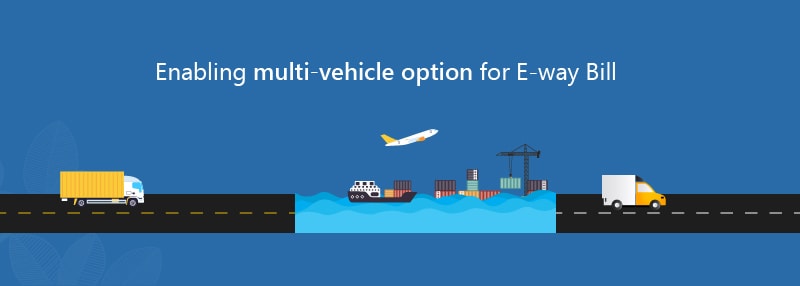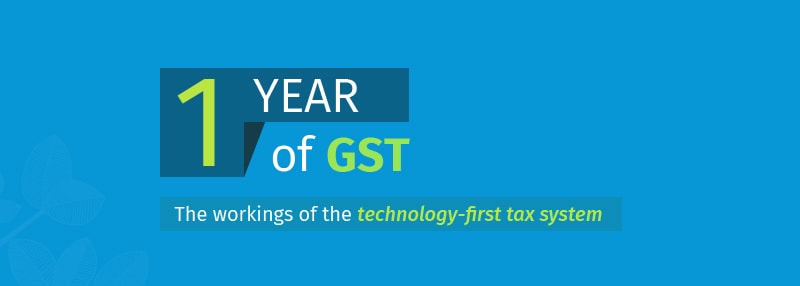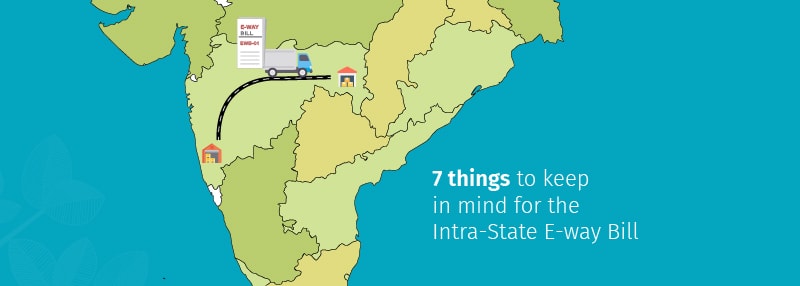Author: Tally Academy
File GSTR-3B using Tally.ERP 9
Filing GSTR-1 using JSON created from Tally.ERP 9
Simplify GST Reverse Charge Transactions using Tally.ERP 9
Getting Started with GST Transactions – Tally.ERP 9 Release 6
Enabling option of single E-way Bill for multiple vehicles
With Delhi going live with the e-way bill on 16th June, the entire country has now moved into the era of the e-way bill, both at inter-State as well as intra-State levels. With no major glitches having been reported across the country, the implementation can be called a success, with lakhs of businesses using the e-way bill portal to generate e-way bills day in and day out.
In the meanwhile, the government and the GST Council have been working to simplify the e-way bill experience for businesses. One of the problems that came to its notice was that there was no provision for a single e-way bill for multiple vehicles. Such a scenario is true especially in two cases:
- The original consignment is a huge one and is transported initially from the origin to the point of trans-shipment via rail or via a big vehicle. But for transporting from the point of trans-shipment to the destination, a similar sized vehicle is not available
- The original consignment is reasonably sized, but the destination is in a hilly area where a big vehicle, although present, cannot be used for delivery of that consignment
In both these cases, the consignment is being split into parts during the second leg of the trans-shipment and then transported to the destination across multiple smaller vehicles. This meant that businesses needed to generate multiple e-way bills for the same consignment, one for each vehicle that was being used for the shipment, which meant loss of time and energy.
In order to solve this problem, the portal has now provided a multi-vehicle option in the e-way bill, i.e. you can now have a single e-way bill for multiple consignments, being transported across multiple vehicles.
Let us understand how you can generate the same on the e-way bill portal.
How to generate a single e-way bill for multiple vehicles?
The following are the steps to be followed:
- Generate the e-way bill with source and destination as per the document or the invoice
- Complete the movement of the consignment from the origin to the point of trans-shipment
- Navigate to the e-way bill portal, select the ‘Change to Multi-vehicle’ option, and update the particular e-way bill for multiple movement, wherein, you specify the total quantity of the consignment and also, the starting point and ending point of the route, where you have the requirement of single e-way bill for multiple vehicles
- Update ‘Part-B’ of the e-way bill, with the vehicle number, quantity loaded etc., once the consignment has been split, and loaded on to the smaller vehicles
- Initiate movement of the consignments
Let us see, how do we execute the steps to enable the provisions of single e-way bill for multiple consignments via multiple vehicles, on the e-way bill portal.
Enabling multi-vehicle option for an e-way bill
As discussed above, the first step is to select the ‘Change to Multi-vehicle’ option from the main menu of the e-way bill portal. On doing so, a screen will open where you need to punch in the e-way bill number, for which you want to enable the multiple vehicle option under e-way bill.

- Enter E-way Bill No – Punch in the e-way bill number here, for which you want to enable the option of single e-way bill for multiple vehicles. On doing so, the EWB details will show up
- Do you wish to move the goods in Multiple vehicles – Set as Yes. This will open up some fields under the Multiple Vehicle Movement Details section
- Mode of Transport – Select Road / Rail / Air / Ship
- From Place* – Specify the origin
- To Place* – Specify the destination
- Total Quantity* – Specify the total quantity of the original consignment
- Unit* – Specify the unit of measurement for the quantity specified
- Reason* – Specify the reason to go for multi-vehicle option
- Remarks* – Any additional remarks
Following these steps will complete the generation of e-way bill for multiple conveyance via multi-vehicle for the specified e-way bill.
Updating multiple vehicle details
Once the option is enabled, you will need to update the e-way bill when multiple vehicle details, whenever any part of the consignment is ready to be moved. Once the first part of the consignment has been loaded onto the first vehicle, and ready to be moved, you can revisit the e-way bill portal and select the ‘Update Vehicle’ option, and feed in the e-way bill number. On doing so, a ‘Multiple Vehicle Updations’ screen will be opened.

If you notice, the groups that are available for selection are in the format “From Place – To Place, Quantity Unitâ€, as per what you have specified for that e-way bill previously. In the example shown above, some goods whose total quantity is 1000 Tons is being transported from one place to another.
Once you select the group, Part-B of the e-way bill will open up for you to feed in the vehicle details:

- Mode of Transport – Select Road / Rail / Air / Ship
- Vehicle No* – Specify the vehicle number in the correct format
- Place of Change* – Specify the place
- Reason* – Specify the reason for change of vehicle
- Transporter Doc. No. & Date – Specify the document no. if any and date of such a document
- Quantity in Vehicle* – Quantity being transported in this part of the consignment. In the example above, the first part of the consignment, transported by the first vehicle is carrying 200 Tons, which means there is still 800 Tons to be accounted for.
This will be repeated multiple times, till all the parts of the consignment have been dispatched across multiple vehicles, resulting in a single e-way bill for multiple consignments.
The print of such an e-way bill will look as follows:
Part A of multi-vehicle e-way bill

Please note that the field ‘Valid Until’, contains the phrase ‘Multi Vehicle’, indicating that this is a multi-vehicle e-way bill.
Part B of multi-vehicle e-way bill

The details of all the vehicles involved in this consignment will be mentioned here, along with details of origin, destination and quantity being carried.
One Year of GST: the Workings of the Technology-First Tax System
I am writing as one of the people who have been in the ‘middle’ of this enormous tax reform – since we provide software solutions to businesses who need to comply with GST. This has given us a view on both sides of the bridge – the Government/GSTN side, and the Business/Practitioner side. The first who needs compliance, and the second, who need to comply.
 Getting a country which is the size of India to do a complete transformation has been extraordinary in itself. Despite all criticism – including mine – on how it could have been better, it remains something that everyone should pat themselves and each other on the back for.
Personally, the most important take-away was the continued expression of good intent by the Government to learn and correct. And not just expression of intent, it was also executive action. Whether it was responding to pains by changing/removing rules and processes, or changing tax rates, or even specific clauses of law – they have stood by the resolve to ‘make it happen’.
Yet, the original promise of GST is expected to come alive only in the months ahead – and their remains a growing urgency for actualizing the latest decisions on this subject taken in the first few months of this year. This relates to the ‘simplification of GST’, and its cascading impact on both rules and law, so that compliance becomes easier, and evasion, more difficult.
The past year has shown that a semi-complete technical process (GSTR-1 but no GSTR-2 – for example), creates not just problems for the Government, but also the taxpayer – since there is no simple way to complete compliance. It leads to confusions of information, conflicts of information, and increases suspicion and mistrust. It penalizes the honest and rewards the dishonest.
The past year has also shown, that being a technology-first tax system, it is far easier to detect the anomalies early rather than late, and therefore, is a strong pointer to the benefits of ‘simplification with completeness’. All the decisions have been taken for what can be called GST 2.0. What we await is the announcements for its actualization. What we await, is the realization of the core promises of GST. What we await, is the economic acceleration that it is capable of.
Managing Director, Tally Solutions Pvt. Ltd.
Recent AAR Rulings – Food, Beverages & Catering Services
AAR Rulings – Canteen Services provided by outside vendors in offices and factories
Rashmi Hospitality Services, based out of Gujarat had filed an application, seeking an advance ruling on whether, the GST rate on supplies made to non-air conditioned canteens of offices and factories, needed to be taxed at 12% GST or 18% GST. In response to this application, the Gujarat bench of the Authority of Advance Rulings stated, that the catering service provided by Rashmi Hospitality Services to recipients who have in-house canteens, where meals, snacks, tea etc., are ultimately consumed by employees or workers, and thus, do not alter the nature of service provided. Thus, the GST rate for such a service will be considered as 18%.
Thus it was a given, that such a move would imply a higher compliance burden for companies, which would translated into higher cost for food. Thus most companies would, understandably, tend to recover the food expenses from employees. To attain further clarity on the same, Caltech Polymers, based out of Kerala had filed an application, seeking an advance ruling on whether, the recovery of food expenses from employees or canteen services would come under the definition of outward supplies, and whether it will attract GST or not.
In response to this application, the AAR Kerala bench stated, that recovery of food expenses from the employees, for the canteen services provided by the company, would indeed come under the definition of “outward supplyâ€, and therefore be considered taxable as a supply of service under GST. However, the authority of advance ruling Kerala, did not clarified, whether the GST rate to be levied was 5% (without ITC), or 18%, treating the same as an outdoor catering service. Irrespective of the rate, such a move is bound to push up the cost of food for employees and factory workers, and also could lead to possible disputes on valuation, which will then need to get solved.
AAR Rulings – Canteen Services provided by outside vendors in educational institutions
Similar to the above scenario, quite a few applications were filed, asking for an advance ruling on the GST rate to be levied on services provided by canteens in educational institutions. In response to the same, the AAR as well as the Ministry of Finance clarified, that food and drinks, served in a mess or a canteen of an educational institution would attract 5% GST, without ITC. However, if schools (only up to higher secondary level) supplied food directly to students, then the same will be exempt from GST.
AAR Rulings – Supply of food and beverages in trains
Deepak & Co, based out of Delhi had filed an application, asking for an advance ruling on the GST rate to be levied on the supply of food and beverages in trains. Deepak & Co, had entered an agreement with the Indian Railways for the supply of food and beverages, packaged, cooked or at MRP, on mail and express trains, and thus needed immediate clarity on the same. The application had come in the aftermath of a circular from the Central Board of Indirect Taxes and Customs (CBIC) in January 2018, which had announced a lower GST rate of 5% for foods and drinks served on trains, platforms or stations by Indian Railways or IRCTC. However, there were a faction of businesses who felt that serving food and drinks on train, was to be treated equivalent to outdoor catering, the rate for which was specified already at 18% GST.
In response to this application, the AAR Delhi bench clarified, that the train is after all, a medium of transport, and thus could not be treated equivalent of a restaurant, eating joint or canteen. Thus, the supply of food and beverages directly to passengers at a fixed rate on platforms or trains, did not have any element of services, and therefore, GST should ideally be charged on the individual items as per their respective applicable rates. The authority of advance ruling Delhi also noted that the mere heating and cooling of beverages were incidental and not eligible for any tax benefit. Thus, in a final AAR ruling, it was stated, that supply of food and beverages in trains will face GST as per the respective items being served and not at the concessional rate of 5% specified by the government earlier.
Intra State E-way Bill : Things to watch out for
It has been almost two months since the inter state e-way bill for movement of goods was rolled out across the nation on the 1st of April, 2018. In parallel, it was decided that intra state e-way bill too shall be rolled out in a phased manner from April 15th, once the system had sufficiently stabilised, with roughly four to five states coming on board every week. Karnataka was the first to join the bandwagon, as it adopted the intra-state e-way bill system from 1st April itself. As of now, a total of 22 states have now gone live – Andhra Pradesh, Arunachal Pradesh, Bihar, Gujarat, Haryana, Himachal Pradesh, Jharkhand, Karnataka, Kerala, Madhya Pradesh, Meghalaya, Nagaland, Sikkim, Telengana, Tripura, Uttarakhand, Uttar Pradesh, Puducherry, Assam, Rajasthan – with Lakshwadeep and Chandigarh being the latest entrants, adopting the intrastate EWB on May 25th.
If official records are to be considered, the entire implementation of the system and the generation of inter-state e-way bills nationwide has been largely successful. Till the 13th of May, i.e. in a period of almost 45 days, more than 4.15 crore e-way bills have been successfully generated, which included more than 1 crore intra state e-way bills for movement of goods. The path thus looks smooth for rest of India to become part of the system as well – Maharashtra is looking to take the leap for intra-state e-way bill on May 31st and Punjab and Goa from June 1st. In any case, both interstate EWB as well as intra state e-way bills for movement of goods will become mandatory from June 3rd, 2018 – which implies that businesses across the country will need to factor in the same, while planning for their respective consignments.
Here’s listing 7 things you can keep in mind, as you prepare your business for the intra state e-way bill:
- You can generate the intra state e-way bill using your GSTIN by logging on to http://ewaybillgst.gov.in. The e-way bill registration process can be completed in a matter of minutes
- E-way bill generation will be done when the value of the taxable consignment, along with the tax value, is more than INR 50000
- If you have sent material for Job Work then either you or the Job Worker can generate the e-way bill
- As a supplier, you can authorize the transporter, e-commerce operator or the courier agency to fill Part A of the e-way bill
- If the distance between your primary place of business and that of the transporter is less than 50 KMs, only Part A of the e-way bill is required to be filled, and Part B is not required to be filled
- Once the e-way bill is generated, the recipient of goods can confirm or deny the receipt of goods before the actual delivery or 72 hours, whichever is earlier
- In cases where the goods are being transported by railways, aeroplane or ship, the e-way bill can only be generated by the supplier or a recipient, and not by the transporter. However, in such cases, an e-way bill can be generated even after the goods shipment has started
It can be safely said that with businesses adhering to these intra state e-way bill guidelines, and with the tax authorities working in tandem to ensure the right compliances for the inter state e-way bill, the nation-wide single e-way bill will soon be a successful reality. Coupled with the obvious advantages of robust technology that businesses will look to use, this will surely ensure seamless commerce across state borders, something which is bound to give both businesses as well as the government authorities a lot of relief in the time to come.
Prosecution and Compounding under GST
Prosecution under GST
Prosecution, is defined as the act of conducting legal proceedings against someone, in respect of a criminal charge. Under GST, any taxable person who commits an offence amounting to deliberate intention of fraud, becomes liable for prosecution, or in other words, criminal charges.
Offenses liable to attract Prosecution under GST
The following are the offences, for which a taxable person can become liable for prosecution under GST:
- Supply of any goods and / or services without an invoice, in order to evade taxes
- Issue of any invoice without the supply of any goods and / or services, thus taking ITC or refund by fraud
- Collection of GST (even if it is done against the provisions), but failure to submit the same to the government, within the specified time limit of 3 months
- Obtaining of refund of CGST / SGST by fraud
- Submission of fake records or documents or filing of fake returns to evade taxes
- Obstruction of the proper officer during his duty, for instance, while conducting audit
- Acquisition or receipt of any goods and / or services with full knowledge that it is in violation of the GST rules, and is liable for confiscation
- Destruction of evidence
- Not providing information or providing false information during proceedings
- Helping any taxable person to commit fraud
Punishment for Prosecutable Offences
As per the provisions of prosecution in GST, the taxable person committing any of the above listed offences i.e. prosecutable offences shall be punished as follows:
| Amount of Tax Involved in Offence | Bail Applicability | Term of Jail |
| INR 100 to 200 Lakhs | Bail-able | Up to 1 year |
| INR 200 to 500 Lakhs | Bail-able | Up to 3 years |
| Above INR 500 Lakhs | Bail-able* | Up to 5 years |
*Note: However, if a taxable person commits the following offences and the amount of tax involved in the offence exceeds INR 500 Lakhs, then the offences will be deemed as non-bail-able:
- Supply of any goods and / or services without an invoice, in order to evade taxes
- Issue of any invoice without the supply of any goods and / or services, thus taking ITC or refund by fraud
- Collection of GST (even if it is done against the provisions), but failure to submit the same to the government, within the specified time limit of 3 months
Other specified punishments for Prosecutable Offences
- For obstruction of the proper officer during his duty, destruction of evidence, falsifying information during proceedings & helping another taxable person to commit fraud – Up to 6 months imprisonment with fine
- Repeat Offences – Up to 5 years imprisonment with fine
Compounding under GST
Compounding of offences under GST is a method, wherein litigation time, and time of judicial procedures can be cut down. Generally, in the case of prosecution for an offence in a criminal court, the accused has to appear before the Magistrate at every hearing by using the services of an advocate. Given, that court proceedings are both expensive and time-consuming, the accused taxable person may make use of the compounding provisions under GST, wherein, he will not be required to appear in Court personally. Also, under the same provisions, he may be discharged on the payment of a compounding fee, which will not be more than the maximum fine which can be levied under the relevant provisions of prosecution and compounding under GST.
However, compounding under GST will not be available to the following entities:
- Any taxable person who has already committed any of the offences mentioned under prosecution, detailed above i.e. repeat offenders
- Any taxable person who has committed an offence involving supplies above INR 1 Crore and has been allowed to compound before
- Any taxable person who is also being tried under other acts such as Narcotic Drugs Act, FEMA etc.
- Any taxable person convicted by a court under GST
- Any taxable person guilty of destruction of evidence, falsifying information during proceedings or preventing an officer from doing his duty
Amount Payable for Compounding under GST
Compounding in GST will be allowed only after the full payment of all taxes, interests and penalties which are due. As per the provisions of prosecution and compounding under GST, the amount payable for compounding under GST is defined as follows:
- Minimum Limit – 50% of the tax or INR 10,000 whichever is less
- Maximum Limit – 150% of the tax or INR 30,000 whichever is more
On payment of the compounding amount, no further proceedings shall be initiated against the accused taxable person for the same offence and all criminal proceedings, if already initiated, will be abated immediately. In conclusion, to avoid any kind of loss, businesses should be aware of the functioning of prosecution and compounding under GST.




